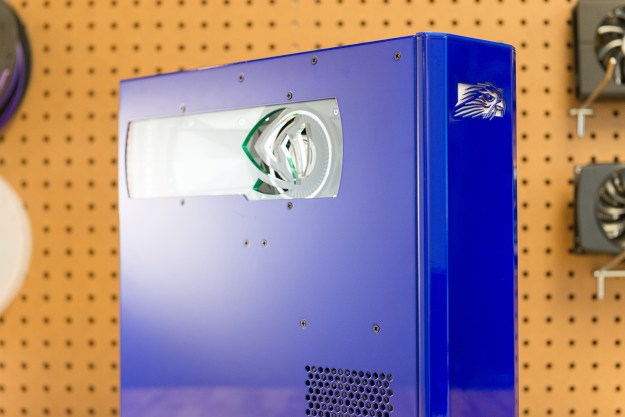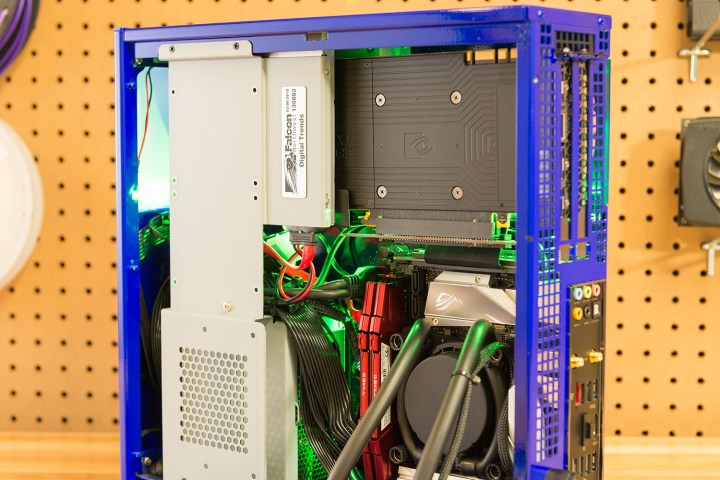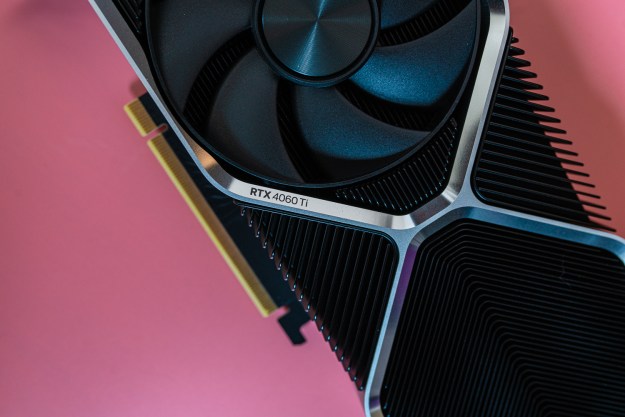
- Powerful internals
- Compact build
- Exceptional build quality
- Sleek design
- Excellent warranty
- Paint job has temporary odor and scratches easily
- Misaligned USB ports on top
The original Falcon Northwest Tiki was one of our all-time favorite gaming PCs. We loved its compact form factor, powerful internals, and unique exterior design. That means the 2018 model has some big shoes to fill.
The latest version of Falcon Northwest’s ultra-compact gaming features an Intel Core i7-8700K processor, an Nvidia GeForce GTX 1080 Ti graphics card, 32GB of RAM, and a 2TB SSD. All for the not very low price of $3,500. Let’s see how it stacks up against of the latest and greatest gaming PCs on the market — and most importantly, let’s find out if it earns that pricetag.
Sleek, shiny, and compact
Just looking at the Falcon Northwest Tiki, it’s immediately apparent that this isn’t your average gaming PC. Instead of a giant tower with a big open window looking into a gaping maw of cables and LED lighting, the Tiki offers a sleek, compact silhouette. It’s small, meticulously engineered, and incredibly well-built. But there’s more to its visual design than you might suspect.
The Falcon Northwest Tiki isn’t just a brightly colored PC, it features an automotive paint job that gives the whole exterior a unique sense of depth. Up close, and under bright lights, the paint becomes luminescent and a little metallic, sparkling like a sports car on a summer drive. But be careful, the automotive paint job behaves exactly like an actual car’s paint job. It can chip and scratch much easier than cheap plastic or normal coated-steel PC cases do. And there’s a bit of an unfortunate side effect: The smell.
The Tiki’s paint job continues to cure and harden and as a result it gives off a bit of an unpleasant chemical smell.
Right out of the box, the Tiki’s paint job continues to cure and harden and as a result it gives off a bit of an unpleasant chemical smell — like an auto body shop. It’s not noticeable unless the Tiki is in a closed room with poor ventilation, or if you get really close to it, but it’s definitely there. During the time we had with the Tiki, the smell did eventually wane to the point that you could only smell it by getting really close to it, but it’s something you should be aware of if you opt for the automotive paint job. It looks great, but it does have a downside.
Port problems
The Falcon Northwest Tiki features all the ports you’d expect out of a gaming PC, with a standard I/O plate in the back, and a couple extra USB ports up top alongside the vertically-oriented optical drive. Everything is easy to reach, and right where you’d expect it. With one tiny exception.

To be clear, this exception is likely just an oversight, not a big deal at all, but when you’re paying $3,500 for a PC, it’s not unreasonable to expect a certain degree of perfection. The problem is the top USB ports. The I/O panel here was not completely fastened to the top plate of the case, so when you try to use either USB port on top, you’re basically pushing the whole I/O panel into the computer. It’s not a good look.
That said, it’s an easy fix, all we had to do was open it up and screw the I/O panel to the top of the case. Still, as we mentioned, it was a little disappointing but nowhere near a deal-breaker. This is still an exceptionally well-built computer in every other respect.
Compact, but not cramped
Inside the Falcon Northwest Tiki the first thing you’re likely to notice is how clean and compact everything is. Remember, this is a very small PC, it has a slim form-factor that would basically fit inside any of our other testing PCs here in the office — with room to spare. The internals in the Tiki are arranged with precision, everything’s carefully fitted together, because there’s not a lot of room in there. Despite the lack of extra space in the interior it doesn’t feel cramped — just dense.
Pull off the side and you’ll immediately have access to the graphics card, the motherboard, RAM, and the M.2 slot. There’s an internal stabilizing bracket that walls off some of the other internal components — like the wiring for the top USB panel — but it’s there for a good reason. It keeps the case stable and holds everything in place during shipping. So, if you pull it out for some at-home cleaning or repairs, remember to put it back if you ever need to ship your Falcon Northwest back for repairs.
There’s really not much to say about the internals here that photos don’t illustrate more clearly. Just look at how everything is laid out in there. The water-cooling unit on the processor has just enough slack to comfortably let down the side panel cable management is tight, efficient, and purposeful.
Six core showdown
The Falcon Northwest Tiki features an overclocked 8th-generation Intel Core i7-8700K, which is a processor you’re going to see pretty often in high-end gaming PCs like this one. It’s quick, powerful, and just about the best you can get in the i7 range. Unlike its i7 predecessors in the 6th and 7th-generations, the i7-8700K is a six-core processor, rather than a quad-core processor. That means for this processor generation Intel has decided to cram more cores onto the chip instead of just speeding up the cores that are there. The end result? This thing is fast.
Looking at how it stacks up to the same processor in a different machine, it’s clear that the Intel Core i7-8700K is quick on its feet in single core performance and multi-core performance. It easily eclipses the performance we got out of the AMD Ryzen 1800X in the Velocity Micro Raptor M60 and demonstrates substantial gains over previous generation processors.
The Falcon Northwest Tiki managed to crunch a 4K video encode in just over three minutes.
For most games, you’re not going to see the Core i7-8700K do much of the heavy lifting, but you will notice when you have about a million browser tabs open with Excel and Word running in the background. The i7-8700K does an excellent job of keeping up with you during everyday productivity tasks.
For an example of the blink-and-you’ll-miss-it speed we got out of the i7-8700K, we just have to look at the Handbrake benchmark. The Falcon Northwest Tiki managed to crunch a 4K video encode in just over three minutes, putting it just ahead of the same processor in the Origin Millennium and a full minute ahead of the AMD Ryzen 1800X.
Quick and quicker
The Falcon Northwest Tiki ships with a huge 2TB SSD in its M.2 slot — the one that fits SSDs the size of a stick of gum. Given the Tiki’s high-end pedigree, it only makes sense that it would be outfitted with a luxuriously large and lightning-quick SSD, and the included Intel 760P M.2 SSD does not disappoint.
Looking at how the 2TB SSD performs against a couple of its peers one thing is abundantly clear: SSDs have become incredibly quick. Looking at read speeds, all three of these PCs managed to hit upward of 2,500 megabytes per second. The Velocity Micro comes in first with 2,876 MB/s, just ahead of the Tiki’s 2,867 MB/s.
Given the Tiki’s high-end pedigree, it only makes sense that it would be outfitted with a luxuriously large and lightning-quick SSD.
Looking at write speed, things slow down a bit with the Tiki hitting 1,504 MB/s — which is still incredibly fast especially considering the Intel 760P is quadruple the size of the SSDs in the Velocity Micro M60 and the Origin Millennium. Speaking of which, the Velocity Micro Raptor M60 took the lead with 2,042 MB/s, to the Origin Millennium’s also impressive 1,972 MB/s.
In practice though, the Falcon Northwest Tiki is very fast — quick enough that it’s not going to slow you down in everyday use. Its expansive storage space plus its incredible performance make it an excellent choice for a compact gaming PC like the Tiki.
1080 Ti Battle Royale
The nice thing about the Nvidia GeForce GTX 1080 Ti is that it’s almost always an impressive graphics card. No matter what system it’s in, this little thing will run just about any game at max settings, and just about any resolution — in 4K, 1440p or 1080p. To be fair, it should run this well, it’s currently the top-of-the-line gaming
Looking at 3DMark, you can see how the 1080 Ti in this machine stacks up against similar builds. The Origin Millennium, one of our favorite gaming desktops, features not one but two GTX 1080 Ti graphics cards running in SLI. The Velocity Micro Raptor M60 features a single GTX 1080 Ti, In our 3D Mark results, the Falcon Northwest Tiki landed right in the middle, just ahead of the Raptor M60 and just behind the double-GPU Origin Millennium.
It’s about what we’d expect out of the GTX 1080 Ti, it likely performed slightly better than the card in the Raptor M60 due to the natural variations you get from card to card, even when they’re the same make and model.
Moving on to our first batch of real-world results, there are some interesting things happening under the hood in the Falcon Northwest Tiki. First, looking at Civilization VI, you’ll notice that the Falcon Northwest came within just a few frames per second of the Origin Millennium despite its dual GPU setup. There are a couple reasons that could be. One, it’s likely Civilization VI doesn’t really need to leverage the power of a two GPU setup, and two, the slightly quicker processor in the Falcon Northwest (due again to natural variations between processors of the same type) likely pushed it ahead since Civilization VI is a bit of a CPU-intensive game.
Looking at the rest of our testing suite, it’s clear that you’re not going to have any trouble at all running games at 1080p on the Falcon Northwest. It sailed through Battlefield 1 at Ultra settings, hitting 185 FPS on average, just barely behind the Origin Millennium, and quite a bit ahead of the Velocity Micro Raptor M60.
The 1080p results set the stage for what we end up seeing further up the scale at 1440p. At this resolution, games looked great and continued to run well on the Falcon Northwest. In Battlefield 1 for instance, we hit an average of 143 FPS at ultra-high settings. Even in Deus Ex: Mankind Divided we saw 70 FPS with all the settings maxed. That’s impressive considering Deus Ex has a bad habit of bringing powerful systems to their knees at higher resolutions.
Which brings us to 4K. The Falcon Northwest Tiki is a very expensive gaming rig so surely it should have no problem running games at
Looking at Deus Ex: Mankind Divided, the Falcon Northwest hit 74 FPS on average with all the settings maxed. Stepping down to High, it hit 48 FPS. In both cases it was just barely behind the Origin Millennium’s dual GPU setup, illustrating just how far you can go on a single GTX 1080 Ti with the right supporting hardware.
This is an exceptional machine.
In a less demanding, but slightly better-looking game, Battlefield 1, the Falcon hit an impressive 74 FPS at Ultra detail in 4K. So as long as you don’t need an ultra-high FPS for a 144Hz monitor, the Falcon Northwest Tiki will be able to keep up with
With a PC this powerful coming out so close to the release of the new HTC Vive Pro, you might be asking yourselves, how well does it handle VR games? That’s an easy question to answer because we used this review model to power the HTC Vive Pro during our review for that product, and the Falcon Northwest Tiki was more than up to the challenge. With its GTX 1080 Ti and powerful Core i7 processor, we never experienced stuttering, lag, or framerates dipping below 90 FPS during while running brand-new VR games like Mage’s Tale.
Our Take
The latest Falcon Northwest Tiki absolutely lives up to the legacy of its predecessors, delivering high-end performance, design, and build quality at a premium price. Other than the minor issues we encountered, there’s not much to complain about here. This is an exceptional machine. Still, let’s break it down and make sure it really earns that $3,500 price tag.
Is there a better alternative?
There are certainly cheaper alternatives on the market, getting a gaming desktop with these specs wholesale or from a different retailer would probably save you some cash. But you would be hard-pressed to find a
The best alternative to a Falcon Northwest Tiki, might just be a slightly different Falcon Northwest Tiki.
The Origin Millennium we used in our test comparisons is more powerful, with two GTX 1080 Ti graphics cards running in SLI, but it’s also about a thousand dollars more expensive. The Velocity Micro Raptor M60 can be outfitted with almost identical specs for about the same price, but you’ll end up missing out on the killer engineering and build quality you get with the Falcon Northwest.
The nice thing about buying from a custom PC builder like Falcon Northwest, is that you have a ton of options available. The Falcon Northwest Tiki is available in dozens of different hardware configurations, With the same 8th-generation chipset as our review model, the Tiki starts at just $2,437 with a GTX 1060.
You can also pick up the Tiki with an X99 chipset, if you’re interested in one of Intel’s high-end 18-core i9 processors. Point is, the Falcon Northwest Tiki can be customized down to the smallest details depending on your budget, so the best alternative to a Falcon Northwest Tiki, might just be a slightly different Falcon Northwest Tiki.
How long will it last?
It’s pretty rare that a gaming PC’s warranty is noteworthy in any way, but the Falcon Northwest Tiki is an exception. Our Falcon Northwest Tiki shipped with a three-year limited warranty covering manufacturer defects and parts and labor.
You also get one year of Falcon Overnight Service, which means if at any point your system develops a serious hardware issue that can’t be solved via technical support, Falcon will pay to have your computer shipped overnight to the Falcon repair facilities, and then overnighted again to get it back to you in a timely manner. That’s pretty impressive, and it is definitely above and beyond what you’d get going with a bigger manufacturer like Dell or HP.
The Falcon Northwest Tiki will likely last a lot longer than your average gaming PC, in part because of the aforementioned Falcon Overnight service. Secondly, the Tiki ships with powerful hardware that is currently the top-of-the-line for gaming PCs. It’s going to be a while before the 1080 Ti starts to show its age, even once Nvidia’s next series of graphics cards end up hitting store shelves. Just look at how long the 980 Ti has remained relevant.
And third, this thing is built like a tank. It might be small but it is dense. The case is solid metal and built to last, chances are your Falcon Northwest Tiki will outlast most of the other electronics in your life.
Should you buy it?
This is always the trickiest question for luxury computers, and the Falcon Northwest TIki definitely falls under that category. It’s hard not to recommend the Tiki, and for that reason we definitely think you should buy it if you’re in the market to invest in a high-end gaming rig. This thing will last a long time, and it’s one of the best-built gaming desktops we’ve had come through our offices in recent memory — even if it does have a few minor downsides.
Editors' Recommendations
- We might have an answer to Intel’s crashing crisis
- Best gaming PC deals: Lenovo Legion, ASUS ROG, Acer Predator
- MSI Claw slammed as ‘impossible to recommend’ in early review
- The best mechanical keyboards you can buy
- The 6 best PC cases in 2024









